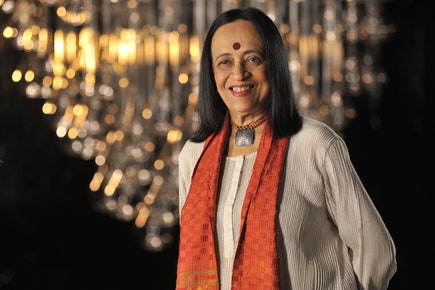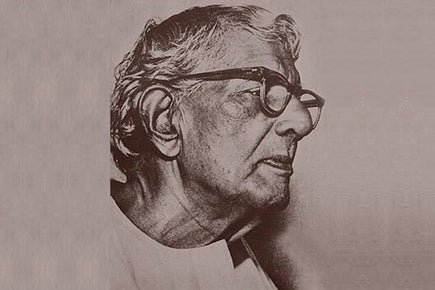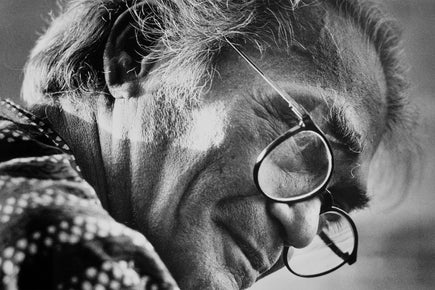V.S. Gaitonde – The Record-breaking Icon of Indian Modernism
Vasudeo Santu Gaitonde (1924-2001) is celebrated as an intellectual pioneer of Indian modernism, specifically abstractionism. One of the most expensive Indian artists with multiple record-breaking auction sales, Padma Shri V.S. Gaitonde was born in 1924 to Goan parents in Nagpur, Maharashtra. After finishing his art diploma at the renowned Sir J. J. School of Art in 1948, he was closely associated with the pivotal Bombay Progressive Artists' Group formed by F. N. Souza, S. H. Raza, M. F. Husain, K. H. Ara, H. A. Gade, and S. K. Bakre in 1947.
 V.S. Gaitonde (Photo by Shalini Saran)
V.S. Gaitonde (Photo by Shalini Saran)
Early exposure
In the 1950s, V.S. Gaitonde’s work was displayed at several exhibitions nationally and internationally. A prodigy from the pioneering era of Indian abstractionism, Gaitonde won the first prize at the Young Asian Artists Exhibition, Tokyo in 1957, followed by the prestigious Rockefeller Fellowship in 1964. His international experiences and India’s post-independence climate thrusting towards globalization, gave his art a complex transculturalism - a cross-hatch of local narratives and international relevance. Interestingly, Gaitonde was averse to the concept of abstractionism and regarded himself as a non-objective painter instead.
 Gaitonde at work in his studio at the Chelsea Hotel, New York, 1965; Photo by Bruce Frisch
Gaitonde at work in his studio at the Chelsea Hotel, New York, 1965; Photo by Bruce Frisch
Experiments with colour
Gaitonde built up his canvas surfaces rather rigorously with rollers and palette knives. He layered the canvas in multiple coats of white to intensify the reflective index of overlaid colours. Upon patiently drying the base, Gaitonde worked with opaque colours followed by transparent or translucent ones. He brought the colours into action by dropping blobs of paint across the canvas which came together and separated into unique patterns. Gaitonde’s paintings are quite perceptive, in that one can trace the courses the colours ran before they ended up in their final pattern. Gaitonde would let the colours be an event exclusive to a painting, and not register the tones and repeat them in others - marking his approach to art as a potent experience that could bear no repetition. With long-drawn stretches of drying time between various phases in a painting, Gaitonde, known to be a perfectionist, committed to his patient process even if he could only complete five to six paintings a year.
 Left - Untitled, oil on canvas, 1958; Right - Untitled, oil on canvas, 1983 (Image Source: Saffronart/Christie’s)
Left - Untitled, oil on canvas, 1958; Right - Untitled, oil on canvas, 1983 (Image Source: Saffronart/Christie’s)
A man of few words
Reinforcing his reputation of being reclusive, his friends and contemporaries remember V.S. Gaitonde constantly getting up to play records of Beethoven and Mozart during their conversations. In paintings or conversation, Gaitonde said very little and interjected the dialogue with long pauses that obliged one to look inward. Seemingly so, the reclusive artist’s paintings are notoriously hard to decipher. While contemplating what he tried to say through his paintings, one should consider the possibility that in a sea of opinions and perspectives, he simply wanted to offer his viewers an island of absolute calm. Though his paintings were created with meticulous nuance, Gaitonde masterfully created an atmosphere of nothingness to absolve the quest for meaning, so one is left to purely experience art.
 Untitled (Bull Fight), conte crayon on paper, 1959 (Image Source: Christie’s)
Untitled (Bull Fight), conte crayon on paper, 1959 (Image Source: Christie’s)
Influences
Gaitonde’s interest in Kandinsky’s ideology of emotive art, and his fondness for classical music seem to have induced a synesthetic effect, as he claimed to hear the colours while painting. It also explains the evocative colour fields of his art, powerful enough to shut out cerebral chaos in a sweeping jolt of tranquillity. This meditative character of his art seems to be a reverberation of his Zen Buddhism beliefs. Similarly, Gaitonde’s interest in calligraphy and ancient hieroglyphs (Egyptian writing system dating back to 32nd century BC) seeped into his artworks too.
 Image Source: Meera Menezes/Bodhana Arts and Research Foundation, Mumbai
Image Source: Meera Menezes/Bodhana Arts and Research Foundation, Mumbai
Later years
In the 1970s, Gaitonde shifted to New Delhi and set up a terrace studio in Nizamuddin East. The 70s were a hugely celebrated decade in Gaitonde’s career, during which he reached the pinnacle of his exploration into pure abstraction by mastering the transcendental possibilities of colour and his painterly expression of silence. Impediments from an unfortunate accident in 1984 limited him to paper sketches in his later years. In 1998, he announced his retirement from painting. A true master of abstraction, when asked why he had stopped painting, Gaitonde quickly responded that “If one is fortunate, painting continually happens within oneself.” Only three years after he announced his retirement, the modern art legend passed away in 2001.
 Gaitonde’s apartment in New Delhi, 1995; Photo by Sunil Kaldate
Gaitonde’s apartment in New Delhi, 1995; Photo by Sunil Kaldate
Posthumous recognition
For a long time since its inception in India, abstractionism was infamous as an alien, un-Indian style. Since the 2010s, with the phenomenal expansion of the South-Asian art market, Gaitonde’s art was suddenly sought after globally. Early collectors of Gaitonde’s art witnessed record-breaking sales that were long overdue for an artist of his calibre.
 Untitled, ink and watercolour on card, 1953 (Image Source: Christie’s)
Untitled, ink and watercolour on card, 1953 (Image Source: Christie’s)
In 2013, over a decade after his demise, Gaitonde’s mustard-hued abstract from 1979 was sold for over Rs. 20 crore ($3.28 million) at Christie’s first auction in India, setting a record for the highest-selling Indian artwork in modern and contemporary art at the time. In 2015, at Christie’s third auction in India, another untitled work of Gaitonde’s from 1995, was sold for an astounding price of Rs. 29.3 crores ($4.4 million), breaking the previous record. In Pundole’s September auction in 2020, Gaitonde’s untitled 1974 oil-on-canvas was sold at a hammer price of Rs. 32 crores ($4.35 million), making it the most expensive Indian artwork as of then.
 Gaitonde’s record-breaking abstracts from 1995 and 1974 (Image Source: BBC/Pundole's)
Gaitonde’s record-breaking abstracts from 1995 and 1974 (Image Source: BBC/Pundole's)
Yet again, breaking his own and Indian art’s world records, in March 2021, Gaitonde’s 1961 oil-on-canvas sold for Rs. 39.98 crores ($5.55 million) at the Spring Live auction at Saffronart. The most expensive Indian artwork at the time, the abstract flaunting viscous blues was inspired by the Arabian ocean. It was one of the last few horizontal paintings he created before switching completely to the vertical format.
 Untitled, oil on canvas, 1961 (Image Source: Saffronart)
Untitled, oil on canvas, 1961 (Image Source: Saffronart)
As rare as Gaitonde’s paintings are in number and valuation, what is even more rare, is Gaitonde’s stroke of genius in creating paintings that provoke new discoveries with every viewing!
























































































